The engine control sensors fully control the engine operation in various operating modes using a microprocessor system
Coolant Temperature Sensor
The coolant temperature sensor is a thermistor (a resistor whose resistance changes with temperature).
The sensor is wrapped in the coolant outlet pipe on the cylinder head.
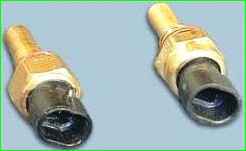
At low temperatures, the sensor has high resistance (at – 40°C – 100 kOhm), and at high temperatures – low (at 100°C – 177 Ohm).
The controller calculates the coolant temperature based on the voltage drop across the sensor.
The voltage drop is high when the engine is cold and low when it is warm.
The coolant temperature affects most of the characteristics that the controller controls.
Knock Sensor
The knock sensor is attached to the top of the cylinder block and detects abnormal vibrations (detonation shocks) in the engine.
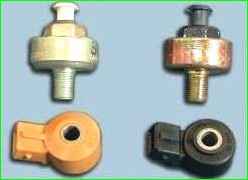
The sensor's sensitive element is a piezoelectric crystal plate.
During detonation, voltage pulses are generated at the sensor output, which increase with the intensity of detonation shocks.
The controller uses the sensor signal to adjust the ignition timing to eliminate detonation flashes of fuel.
MAF
The mass air flow sensor is located between the air filter and the left side of the air supply pipe.
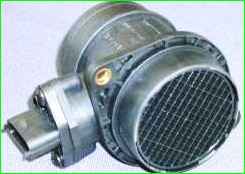
It contains temperature sensors and a heating element. resistor.
The passing air cools one of the sensors, and the electronic circuit of the sensor converts this temperature difference into an output signal for the electronic control unit.
In different versions of fuel injection systems, two types of mass air flow sensors can be used.
They differ in design and in the nature of the signal they produce, which can be frequency or analog.
In the first case, the frequency of the signal changes depending on the air flow, and in the second case, the voltage.
The ECU uses information from the mass air flow sensor to determine the duration of the injector opening pulse.
Speed sensor
The vehicle speed sensor is installed on the transfer case between the speedometer drive and the tip of the flexible speedometer drive shaft.
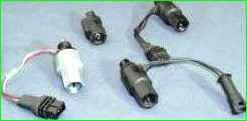
The sensor operates on the Hall effect.
The sensor sends rectangular voltage pulses to the controller with a frequency proportional to the rotation speed of the drive wheels.
Throttle position sensor
The throttle position sensor is mounted on the side of the throttle assembly and is connected to the throttle axis.
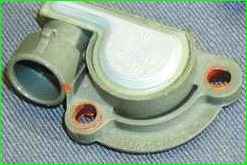
The sensor is a potentiometer, one end of which is supplied with positive supply voltage (5 V), and the other end is connected to the "ground".
The third terminal of the potentiometer (from the slider) sends an output signal to the controller.
When the throttle valve is turned (from the action on the control pedal), the voltage at the sensor output changes.
When the throttle valve is closed, it is lower than 0.7 V.
When the valve opens, the voltage at the sensor output increases and when the valve is fully open, it should be more than 4 V.
By monitoring the output voltage of the sensor, the controller adjusts the fuel supply depending on the opening angle of the throttle valve (i.e. at the driver's discretion).
The throttle position sensor does not require any adjustment, since the controller perceives idle speed (i.e., complete closure of the throttle valve) as a zero mark.
Crankshaft sensor
The crankshaft position sensor is an inductive type, designed to synchronize the controller with the top dead center of the pistons of the 1st and 4th cylinders and the angular position of the crankshaft a.
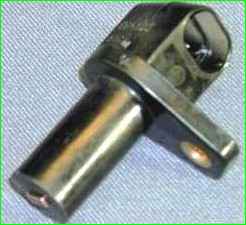
The sensor is mounted on the timing cover opposite the timing disk on the crankshaft pulley.
The timing disk is a toothed wheel with 58 equally spaced (6°) depressions.
With this pitch, 60 teeth fit on the disk, but two teeth are cut off to create a synchronization pulse ("reference" pulse), which is necessary to coordinate the controller's operation with the TDC of the pistons in the 1st and 4th cylinders.
When the crankshaft rotates, the teeth change the magnetic field of the sensor, inducing AC voltage pulses.
The installation gap between the sensor core and the disk tooth should be within (1±0.2) mm.
The controller determines the crankshaft speed using the sensor signals and sends pulses to the injectors.
Oxygen sensor
The oxygen concentration sensor (lambda probe) is installed on the exhaust pipe of the exhaust system.
The oxygen contained in the exhaust gases reacts with the oxygen sensor, creating a potential difference at the sensor output.

It changes from approximately 0.1 V (high oxygen content - lean mixture) to 0.9 V (low oxygen - rich mixture)
For normal operation, the sensor must have a temperature of at least 360°C. Therefore, a heating element is built into the sensor for quick warm-up after starting the engine.
By monitoring the output voltage of the oxygen concentration sensor, the controller determines which command to send to the injectors to adjust the composition of the working mixture.
If the mixture is lean (low potential difference at the sensor output), then a command is given to enrich the mixture.
If the mixture is rich (high potential difference), a command is given to lean the mixture.





